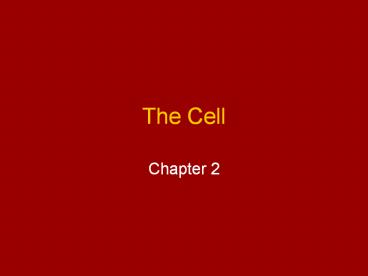The Cell PowerPoint PPT Presentation
Title: The Cell
1
The Cell
- Chapter 2
2
Outline
- Cell theory
- Eukaryotic cell
- Cell structure
- Cell function
3
Cytology
- Study of structure and function of cell
- Identified by Robert Hooke, 1665
- 50-100 trillion!!!
4
Cell Theory
- All known living things are made up of cells
- The cell is the structural and functional unit of
all living things - All cells come from pre-existing cells by
division - Cells contain hereditary information which is
passed from cell to cell during cell division - All energy flow (metabolism biochemistry) of
life occurs within cells
5
Cell Categories
- Sex cells
- Cells specialized for sexual reproduction
- Found only in the gonads
- Created by meiosis
- Somatic cells
- All remaining cells in the body
- Varied in structure function
- Created by mitosis
Sex Cells
6
Somatic Cells
Cells exhibit patterns of form and function
7
The Cell in a Nutshell
8
Extracellular Matrix
- The substance in which animal tissue cells are
embedded - Matrix structure
- Proteins
- Polysaccharides
- Support
- Adhesion
- Movement
- Regulation
9
Membrane Structure Function
- Plasma membrane
- Phospholipid bilayer
- Fluid Mosaic model
- Selective permeability
- Function
- Physical isolation
- Regulation of exchange with the environment
- Sensory
- Structural support
10
Phospholipid Membrane
11
Fluid Mosaic Model
12
Membrane Proteins
13
Cell Recognition
14
Cytoskeleton
- Infrastructure of cell
- Maintains shape
- Mechanical support
- Organelle suspension
- Movement
- Cell division
15
Cytoskeleton Elements
- Microfilaments
- Connect with cell proteins
- Active movement
- Ex muscles
- Microtubules
- Cell skeleton
- Spindle fibers, cilia, flagella
- Microvilli
- Projections of cell surface
- Increase surface area
- Ex small intestine
16
Microfilaments
- http//dept.kent.edu/projects/cell/intro2.htm
17
Cilia Flagella
Microtubule (9-2)
18
Microvilli increase surface area
19
Cytoplasm
- Space inside the cell contains contents of the
cell - Cytosol
- Intracellular fluid
- Contains
- Dissolved nutrients ions
- Proteins enzymes
- Amino acids lipids
- Wastes nutrients
- Inclusions- stored nutrients
- Glycogen granules
- Lipid drops
- Organelles
20
Organelles
- little organs
- Specialized compartmentalized regions of cell
- Perform specific functions
- Vary according to cell function
- Suspended in cytosol, anchored by cytoskeleton
21
Nucleus
- Nuclear envelope
- Double membrane
- Nuclear pores
- Chromatin
- (Chromosomes)
- Nucleolus
22
Chromatin vs Chromosomes
23
Ribosomes
- Produced in the nucleus by nucleolus
- Active in cytoplasm
- Cytosol- free
- Endoplasmic reticulum- fixed
- Site of protein synthesis
24
Endomembrane System
- Multi-organelle system
- Functions in synthesis distribution of cellular
products - Endoplasmic reticulum
- Smooth rough
- Golgi apparatus
- Vacuoles
25
Endoplasmic Reticulum
- Tube sac structure
- Internal compartment
- Smooth ER
- Enzymes
- Lipid synthesis
- Detoxification
- Rough ER
- Ribosome
- Membrane proteins
- Secretory proteins
26
Golgi Apparatus
- Storage, modification, distribution
- Enzymes other proteins
- Receive products from ER
- Address packages
27
Vacuoles aka Vessicles
- Membranous sacs
- Functionally variable
- Derived from organelles
- ER
- Golgi
- Plasma membrane
- Diverse function
- Movement/ Pumps
- Transport vesicles
- Intracellular Digestion
- Lysosomes
- Storage
- Toxins
- Food
28
Lysosome
- Breakdown body
- Sacs of Digestive enzymes
- Proteins
- Polysaccharides
- Fats
- Nucleic acids
- Damaged cells organelles
29
Lysosomal Storage Diseases
- Disease of missing lysosomal enzyme
- Results in an inability to process molecules
naturally - Results in the accumulation of the undigested
molecule until they interfere with cell function - Ex. Tay-sachs disease
- Missing enzyme that breaks down lipids in nerve
cells - Impairs nerve function causes
30
Mitochondria
- Powerhouse of the cell
- Conversion of chemical energy to cellular energy
- Production of ATP via aerobic respiration
31
Cell Function
- Membrane Permeability
- Ability of molecules to move in /or out of a
cell - Selectively permeable
- Allows passage of some but not others
- Size
- Electrical charge
- Molecular shape
- Lipid solubility
32
Membrane Transport
- Passive transport
- No direct energy investment required
- Diffusion
- Osmosis
- Filtration
- Facilitated diffusion
- Active transport
- Requires ATP
33
Diffusion
- Net movement of molecules from an area of high
concentration to and area of low concentration - Driven by random movement
- High concentration to low concentration
- down a concentration gradient
- Dynamic equilibrium
- The tendency for molecules to spread out evenly
in an available space - Net movement
34
Diffusion can occur across a membrane
35
Osmosis
- Passive transport of a solute (water) across a
selectively permeable membrane - Pattern of net movement
- Movement directed by solute concentrations
pressure
36
Osmoregulation
37
Filtration
- Movement of a fluid across a semi-permeable
membrane - Driven by pressure
38
Facilitated Diffusion
- Passive diffusion across a selectively permeable
membrane with the assistance of a carrier
membrane protein - Requires NO ATP
39
Active Transport
- Requires cellular energy (ATP)
- Works against concentration gradient
- Endocytosis
- Phagocytosis
- Pinocytosis
- Exocytosis
40
Endocytosis Exocytosis
Possible because of the fluid nature of the
plasma membrane
41
Cell Division
- Duplication division separate stages
- Interphase
- Mitosis cytokinesis
- 2 types of division
- Mitosis
- Meiosis
- Differential rates

